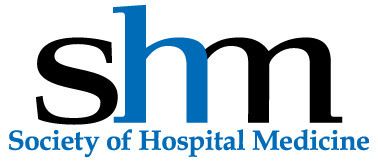Founded 1997 | Type of business Nonprofit organization | |
 | ||
Industry Hospital Medicine, Hospitalists, Internal Medicine Key people Laurence Wellikson, MD, SFHM (CEO); Burke T. Kealey, MD, SFHM (Current President) Website www.hospitalmedicine.org Similar American College of Physicians, American Board of Internal M, American Hospital Association, Accreditation Council for Graduate, Kaiser Family Foundation Profiles | ||
Society of hospital medicine the home for hospitalists
The Society of Hospital Medicine (SHM) is an American membership society for hospitalists, that is, physicians and other caregivers who practice the specialty of hospital medicine.
Contents
- Society of hospital medicine the home for hospitalists
- Staff care attends the society of hospital medicine 2016 conference
- History
- Continuing Education and Professional Development
- Continuing Medical Education CME and Maintenance of Certification MOC
- Project BOOST
- Advocacy and Public Policy
- Relationship with Sanofi Aventis
- References
SHM is focused on supporting the hospital medicine industry and individual hospitalists. SHM provides continuing education and industry updates for hospitalists in its monthly publication, The Hospitalist, and peer-reviewed journal for hospital medicine, the Journal of Hospital Medicine. In addition to its publications, SHM conducts surveys, prepares written analyses and offers discussion forums that aid in the overall development of the specialty of hospital medicine.
SHM is focused on providing resources, programs and mentoring for quality improvement program for reducing readmissions and hospital acquired diseases while optimizing transitions of care, glycemic control and overall patient care. An integral role of SHM has been the development of policy and position statements to address the concerns and issues of hospitalists and advocating on behalf of hospitalists before government and regulatory agencies.
Staff care attends the society of hospital medicine 2016 conference
History
Founded in 1997 by Internists John Nelson, MD, MHM, of Bellevue, Washington and Winthrop Whitcomb, MD, MHM, of Springfield, Massachusetts, SHM was originally known as the National Association of Inpatient Physicians (NAIP). SHM’s goals include promoting high-quality care for hospitalized patients; advancing education and research in hospital medicine; enhancing medical teamwork to achieve the best care for hospitalized patients; supporting career paths to attract and retain high quality hospitalists; defining competencies, activities and needs of the hospitalist community; and advocating, proposing, and promoting changes to the healthcare system that lead to better care by hospitalists.
A History of SHM, and in many ways the Hospital Medicine Movement:
Continuing Education and Professional Development
The specialty of hospital medicine is made up of a varied constituency with both overlapping and discrete educational needs. These constituencies include academic hospitalists, clinicians-internists, family physicians, pediatricians, hospital medicine group leaders, researchers, clinical educators, nurse practitioners, physician assistants, hospital administrators, and pharmacists.
The Society focuses on lifelong learning for all of these. Its main focus is the enhancement of hospitalists’ knowledge on topics related to specific clinical situations and the fostering of independent learning through traditional and emerging channels.
Members of SHM can also be earn or be nominated to become a Fellow and Senior Fellow in Hospital Medicine.
The Society of Hospital Medicine’s Fellows Program is rooted in the Society’s Core Competencies in Hospital Medicine. Those who earn the Fellow in Hospital Medicine (FHM), Senior Fellow in Hospital Medicine (SFHM) or Master in Hospital Medicine (MHM) designations have demonstrated their commitment to hospital medicine, system change and quality improvement principles.
Masters in Hospital Medicine are distinguished by the excellence and significance of his or her contributions to the field of hospital medicine and healthcare as a whole. They have been selected because of: Personal character, positions of honor, contributions towards furthering the goals of the Society of Hospital Medicine, distinction in practice education, medical research, and other achievements in science or in the art of hospital medicine.
Continuing Medical Education (CME) and Maintenance of Certification (MOC)
Hospital medicine is the first area to be awarded focused practice recognition by ABIM, a major milestone for the field.
Project BOOST
Project BOOST (Better Outcomes by Optimizing Safe Transitions) is an initiative wherein hospitals receive expert monitoring and peer support to aid in improving the care of patients as the transition from hospital to home. BOOST members help hospital teams to map current processes and create and implement actions plans for organizational change. BOOST provides a suite of evidence-based clinical interventions that can be easily adapted and integrated into each unique hospital environment. By improving the hospital discharge care transition. Project BOOST aims to:
Project BOOST centers around 5 Key Elements, and there are currently over 180 mentor sites, located in 31 United States and one in Canada, which participate in Project BOOST.
Advocacy and Public Policy
In recent years, SHM and its members have changed the healthcare landscape by:
Relationship with Sanofi-Aventis
In May 2011, staff of the Senate Finance Committee issued a report concerning Sanofi-Aventis efforts to secure favorable comments from medical societies to the Food and Drug Administration. These comments raised safety concerns about generic equivalents to the Sanofi-Aventis product Lovenox.
The report, initiated as a result of an article by Alicia Mundy in the Wall Street Journal, and a physician (Victor Tapson, MD) as having submitted comments as part of the Citizen Petition Process without disclosing in the letter their financial ties to the pharmaceutical. In the case of SHM, those ties amounted to over $2.0M (since 2007) for a variety of uses that included exhibit space, sponsorship and other outreach.
